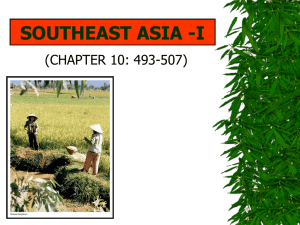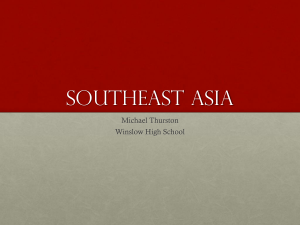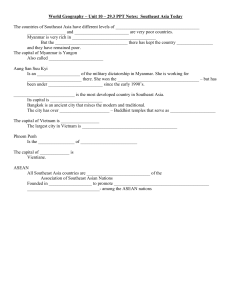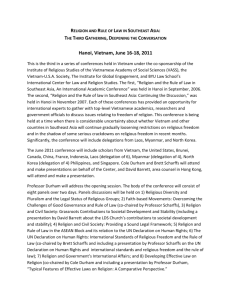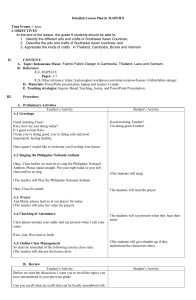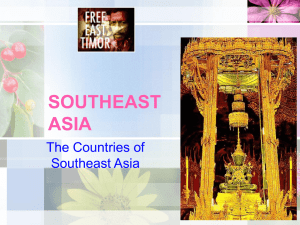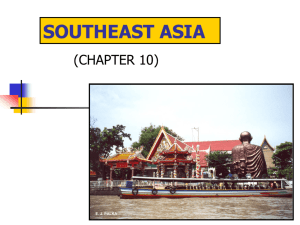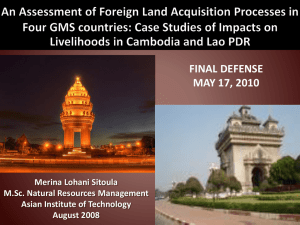Southeast Asia
advertisement
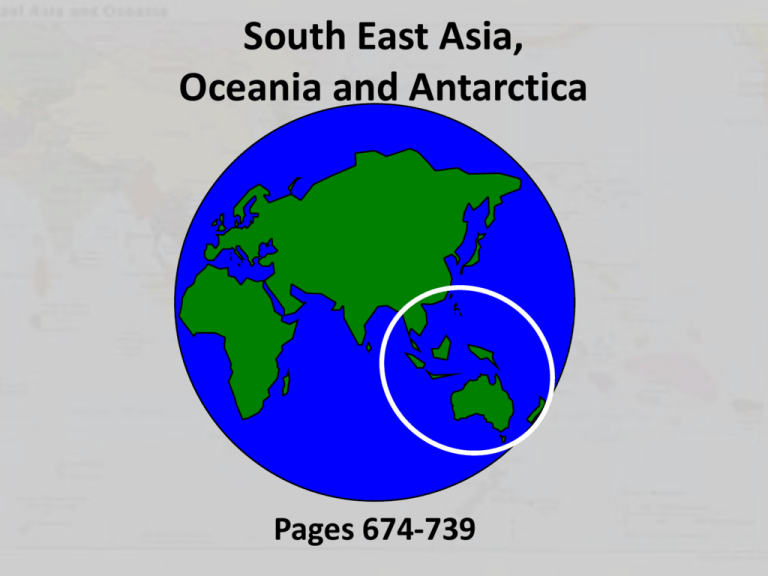
South East Asia, Oceania and Antarctica Pages 674-739 Overview 4-3 Tuesday – Introduction to Unit 10 /Maps 4-4 Wednesday – Physical and human patterns, land forms and resources 4-5 Thursday – Research in Library for Brochure 4-6 Friday – No School 4-9 Monday – Southeast Asia 4-10 Tuesday – Oceania 4-11 Wednesday – Australia, New Zealand, Antarctica 4-12 Thursday – Brochure presentation/review 4-13 Friday – Unit Exam Due Dates 4-10 Tuesday – Brochure rough draft 4-11 Wednesday - Maps – Political and Physical 4-12 Thursday – Final Brochure 4-13 Friday - Current Event 4-13 Friday - Unit Exam ***You may use a 3”x5” note card on this exam*** Physical Coral Sea Darling River Great Australian Bight Great Artesian Basin Great Barrier Reef Great Dividing Range Great Sandy Desert Java Sea Kimberly Plateau Malay Peninsula Mekong River South China Sea Political Australia Cambodia Cook Islands Federated States of Micronesia Fiji French Polynesia Guam Indonesia Kiribati Laos Malaysia Marshall Islands Myanmar New Zealand Palau Papua New Guinea Philippines Pitcairn Samoa Solomon Islands Thailand Tonga Tuvalu Vanuatu Vietnam Maps are Due Wednesday April 11th Southeast Asia History of Diversity Economy Culture Vietnam, Laos, Cambodia, Myanmar, Thailand, Indonesia, Philippines, Brunei, Malaysia. History of Diversity– Chinese and Indian influence. China ruled Vietnam (111 B.C. – 939 A.D.) art, ethnic beliefs, political ideas, and technology Hinduism and Buddhism from India. Southeast Asia kept many of its traditions. Mandalas instead of states (rings of power around a central court). 1300-1800 – Individual states grew larger, had national identities and developed trade economies. 1360 A.D. 400 – 1300 A.D. Khmer Empire 800-1400 A.D. Colonialism 1500s Europeans arrive in force Spanish set up colonies in the Philippines. Europeans did as they always did and took advantage of resources and people. All Southeast Asia was colonialized except for Siam. (Thailand.) Outcomes – Bureaucratic governments Forced production of commodities needed in Europe. Unintentionally sparked nationalism. Independence – Japan claimed to “take back Asia for Asians” in WWII. After WWII SE Asian nations sought independence. Many nations gained independence peacefully. Indonesia fought the Dutch 1945-1949. Indochina (Cambodia, Laos, North and South Vietnam) won independence from French in 1954. North Vietnam attacked South Vietnam and started the Vietnam War 1957-1975. After the war Vietnam, Laos and Cambodia were all communist countries. Economics – Traditional economies – agriculture Decades of war and turmoil have retarded economies. ASEAN (Association of Southeast Asian Nations) promotes economic growth and peace. Manufacturing has grown rapidly since the 1960s. Processing agricultural products Textile production, clothing and electronics. Finance and other service industries. Culture – Religious diversity – many different religions because of outside influences. Buddhism and Hinduism shaped sculpture and architecture. Southeast Asia is famous for performing arts and literature. Vietnam has a 3,253 line poem called “Kim van Kieu”, about love and sacrifice. Angkor Wat is a temple complex at Angkor, Cambodia, built by King Suryavarman II in the early 12th century as his state temple and capital city. Buddhist Temples in Thailand. Indonesian Dance. Changing Lifestyles – Most live in rural villages but the trend is to move to cities and live more modern life. The villages – wood houses built on stilts. A group of leaders or the Buddhist temple serves as local leadership. Many people still wear traditional clothing. The cities – very modern with skyscrapers and slums because of overpopulation, pollution and poor housing. Review Why did European and Japanese powers seek control in SE Asia? To obtain region’s wealth and resources. How did colonialism help cause independence? European rule lead to nationalism, Japan let SE Asians gain political experience. Why did the U.S. become involved in Vietnam? Communist north invaded the south. What is the major basis for income and industrial processing in Southeast Asia? Agriculture. Why is industry unevenly distributed in the region? Some areas like Vietnam have experience years of turmoil, war and destruction. How is ASEAN aiding industrial development? By uniting all of Southeast Asia in causes of economic growth and peace. What foreign influences are seen in sculpture and architecture? Buddhism and Hinduism How are traditional ways changing in Southeast Asia? Many people are migrating the cities and adopting modern lifestyles. What problems do cities face? Housing shortages, pollution and unsafe living conditions.
